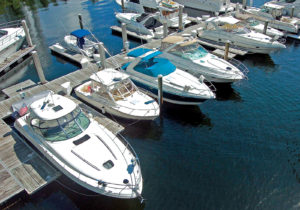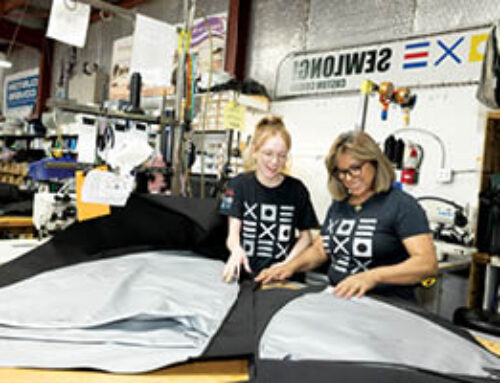Tech blows in
 OK, you’re afloat in the Bahamas. The enclosure protecting your pilot house blows out. You need a fix right away.
OK, you’re afloat in the Bahamas. The enclosure protecting your pilot house blows out. You need a fix right away.
Wind, waves, weather—it happens all the time, but replacement isn’t always easy. In many such cases, an enclosure must be fitted carefully to your specific boat.
So, stuck there in the Bahamas, you contact the people who made your enclosure and ask for a new one as soon as possible. Some providers might say it will take a couple of days or longer to find your particular design and build a new one for you.
Mike Garrison maintains he can pull up the plan for your enclosure on his computer and have the pieces cut, assembled and shipped the same day.
What’s he got that the others don’t?
Some shops still use paper plans, says Garrison, who is CAD (computer-aided design) manager with Canvas Designers in Riviera Beach, Fla. Such fabric makers still rely on “a room full of patterns,” he thinks. To rebuild something for a boat, he claims, they must “rifle through all these patterns for hours just to find one.”
Having plans immediately accessible on computer files is nothing new, but when it comes to marine-fabric design these days, that’s only the beginning. Garrison makes a point of watching for and trying out the latest technology, and other shops contact him for tech advice on boosting productivity and more quickly turning around their own projects. Meanwhile, fabric makers line up at seminars—including IFAI shows—to find out more about such techniques.
Some boats have unique designs; others are fairly standard. Say you use a technology called Proliner to measure a cover for the popular Sea Ray 180 boat model. In this case, once you have that design for the 18-foot boat, you can use it as often as needed for other Sea Ray owners. Canvas makers “have that pattern forever,” says Drew Thornton, who works in sales and training for Prodim, the maker of Proliner. Prodim, based in the Netherlands, has a U.S. training center in Fort Pierce, Fla.
Downside?
Andy Moon uses Proliner with software called AutoCAD and MPanel to speed up pattern work and allow for quicker production of items. You can store such patterns on your computer “instead of in a box taking up space,” notes Moon.
Technology’s down side? “Learning curve,” says Moon, owner of Baraboo Tent & Awning in Baraboo, Wis.—and you “need a tech-savvy person” to run the software.
Then there’s the cost. Take a deep breath: Proliner starts at $27,600—but consider the payback: 15 minutes to measure a boat, claims Prodim’s Thornton. And Thornton maintains Proliner isn’t hard to learn. “We can teach somebody to run Proliner in half a day,” he says.
How long it takes beginners to learn a new technology depends, says Canvas Designers’ Garrison. “If they have any drafting experience—which they should after dealing with patterns on the table—they can learn the essentials in a week to two weeks,” he estimates.
What’s next for tech hound Garrison? He’s considering a handheld digitizer that uses infrared light to map a boat deck. The device looks a little like a paint gun, he says. You squeeze the trigger, and it maps the area where you want to attach a cover.
He’s not ready to spring for it just now. “The technology isn’t quite there yet for what we want.”
Still stranded in the Bahamas? That’s not the worst place to be. Yet you’re supposed to be someplace else pretty soon. So having access to a fabricator who can help quickly is a big deal. And with technology, marine fabricators are going places.
Marc Hequet is a freelance writer from St. Paul, Minn.
 TEXTILES.ORG
TEXTILES.ORG 






